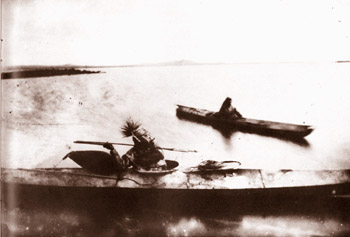
The men of the village had to be expert hunters because their families' survival depended upon their skills. The hunters used the animals they killed in many ways: the flesh and blubber, for food; the bones, antlers, and ivory, for tools; the skin and sinew, for clothing, boat covers, and blankets. They wasted no part of an animal.
Two sea mammals, the seal and the walrus, were important sources of meat, skin, oil, ivory, and bones. Eskimo hunters perfected a variety of techniques to hunt these and other animals through the changing seasons. They hunted walruses from boats and captured muskrat, mink, caribou, and deer in traps and snares. In winter, they harpooned seals as they surfaced for air at their breathing holes. In spring they clubbed seals as they sunned on the open expanses of ice.
Bering Sea Eskimo hunters used a swift, lightweight boat, or kayak, to pursue birds, fish, and other game over the lakes and open seas. Made to hold one or two persons, the kayak had a frame of wood or bone with a tight-fitting skin cover. The hunter climbed into a small opening in the top of the kayak and sat with his legs inside the boat and his parka tied around the opening. In this snug position, he could paddle swiftly without fear of ice-cold water entering his boat.
Eskimo hunters had enormous respect for their quarry. They believed that every living thing possessed a spirit or inua. According to Eskimo tradition, an animal's inua was humanlike in form and continued to live after the animal was killed. If an animal's inua was pleased by hunters, it would become the spirit of a newborn animal, thus ensuring plentiful game on Earth.
A hunter, therefore, had to be skillful not only with his weapons but also with his knowledge of the spirit world. He had to know how to control and please the spirits. Often hunters created exquisitely carved weapons in the shape of an animal's natural predators. These weapons were made of materials familiar and comforting to the intended prey. By depicting the predator, a hunter hoped to gain the speed and cunning of that animal in his own pursuit.
The hunter also needed an understanding of the spirit world for the ceremonial dances of winter. On these important occasions, he might wear a richly symbolic inua mask. A inua mask often portrayed an animal with its inua shown as a small, semihuman face surrounded by hoops that symbolized the heavens. Bering Sea Eskimos believed that through these masks and ceremonial dances the spiritual, animal, and human worlds became fused, ensuring successful future hunts.